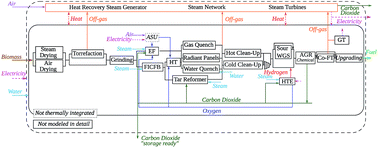当前位置:
X-MOL 学术
›
Sustain. Energy Fuels
›
论文详情
Our official English website, www.x-mol.net, welcomes your
feedback! (Note: you will need to create a separate account there.)
Thermo-economic analysis and multi-objective optimisation of lignocellulosic biomass conversion to Fischer–Tropsch fuels†
Sustainable Energy & Fuels ( IF 5.0 ) Pub Date : 2018-03-17 00:00:00 , DOI: 10.1039/c7se00468k Emanuela Peduzzi 1, 2, 3, 4, 5 , Guillaume Boissonnet 5, 6 , Geert Haarlemmer 5, 6 , François Maréchal 1, 2, 3, 4
Sustainable Energy & Fuels ( IF 5.0 ) Pub Date : 2018-03-17 00:00:00 , DOI: 10.1039/c7se00468k Emanuela Peduzzi 1, 2, 3, 4, 5 , Guillaume Boissonnet 5, 6 , Geert Haarlemmer 5, 6 , François Maréchal 1, 2, 3, 4
Affiliation

|
This paper addresses the techno-economic evaluation and optimisation of processes converting lignocellulosic biomass into liquid fuels, through the development of a suitable framework and the modelling and design of Biomass to Liquids (BTL) processes. In particular, the focus is on the production of drop-in fuels through gasification and Fischer–Tropsch (FT) synthesis. Several conversion technologies are presented and evaluated in the literature, but the comparison of different options is hazardous because of the different assumptions and methodologies adopted in each study. A systematic and consistent approach is therefore developed to explore the trade-offs of alternative process configurations and of the operating conditions. The comparison presented in this study explores the trade-offs of different technological options in terms of competing economic and thermodynamic objectives. Results show that for 200 MWth biomass input plant capacities, production costs are in the range of 1.0–1.4 € l−1 for technologies producing up to about 0.5 kJFT kJth−1 and close to being neutral in terms of electricity balance. For technologies using electrolysis the conversion can increase to 0.8 kJFT kJth−1 with production costs of 1.8 € l−1. The electricity storage capacity, in this case, is of 0.5 kJe kJFT−1, corresponding to a net electricity requirement of about 0.4 kJe kJth−1.
中文翻译:

木质纤维素生物质转化为费-托燃料的热经济分析和多目标优化†
本文通过开发合适的框架以及生物质到液体(BTL)过程的建模和设计,致力于技术经济评估和将木质纤维素生物质转化为液体燃料的过程的优化。特别是,重点是通过气化和费-托合成技术生产直接燃料。文献中介绍并评估了几种转换技术,但是由于每个研究采用的假设和方法不同,因此比较不同的选择非常危险。因此,开发了一种系统且一致的方法来探索替代工艺配置和操作条件之间的权衡。本研究中提出的比较从竞争的经济和热力学目标出发,探索了不同技术选择之间的权衡。结果表明,对于200 MW对于生物质输入工厂的能力,对于生产最高约0.5 kJ FT kJ th -1的技术,生产成本在1.0–1.4€l -1的范围内,并且在电力平衡方面接近中性。对于使用电解的技术,转化率可以提高到0.8 kJ FT kJ th -1,生产成本为1.8€l -1。在这种情况下,蓄电容量为0.5kJ e kJ FT -1,对应于约0.4kJ e kJ th -1的净电力需求。
更新日期:2018-03-17
中文翻译:

木质纤维素生物质转化为费-托燃料的热经济分析和多目标优化†
本文通过开发合适的框架以及生物质到液体(BTL)过程的建模和设计,致力于技术经济评估和将木质纤维素生物质转化为液体燃料的过程的优化。特别是,重点是通过气化和费-托合成技术生产直接燃料。文献中介绍并评估了几种转换技术,但是由于每个研究采用的假设和方法不同,因此比较不同的选择非常危险。因此,开发了一种系统且一致的方法来探索替代工艺配置和操作条件之间的权衡。本研究中提出的比较从竞争的经济和热力学目标出发,探索了不同技术选择之间的权衡。结果表明,对于200 MW对于生物质输入工厂的能力,对于生产最高约0.5 kJ FT kJ th -1的技术,生产成本在1.0–1.4€l -1的范围内,并且在电力平衡方面接近中性。对于使用电解的技术,转化率可以提高到0.8 kJ FT kJ th -1,生产成本为1.8€l -1。在这种情况下,蓄电容量为0.5kJ e kJ FT -1,对应于约0.4kJ e kJ th -1的净电力需求。










































 京公网安备 11010802027423号
京公网安备 11010802027423号